Go to EVIS LUCERA ELITE Bronchoscopy
Introducing EVIS LUCERA ELITE
OLYMPUS technology continues to advance the art of endoscopy. As the world leader in endoscopy, OLYMPUS provides cutting-edge medical technology to healthcare professionals around the globe. Our commitment to research and development and our collaborative efforts with the medical community work to improve both the underlying technology and the quality of patient care it helps deliver. It is a continuous evolution, aimed at advancing the art of endoscopy.
Our latest introduction, the new EVIS LUCERA ELITE endoscopy system, is setting new standards for technologies focusing on:
- Advancing Visualization
- Advancing Control
These innovative technologies help facilitate more accurate diagnosis and treatment, simplify setup and reprocessing, improve workflow, and link patient and department information to the hospital’s information network through smart technologies with advanced levels of sophistication and integration.
Enhanced Image Quality
OLYMPUS GIF-HQ290 and CF-HQ290L/ I employ advanced OLYMPUS optics, improved image sensors and the new CV-290 video processor to deliver exceptionally clear, high-resolution images. The great performance of both GIF-HQ290 and CF-HQ290L/ I, and the EVIS LUCERA ELITE system combine to achieve ideal imaging results. In the EVIS LUCERA ELITE generation, high-definition imaging will become standard on the core range of endoscopes.
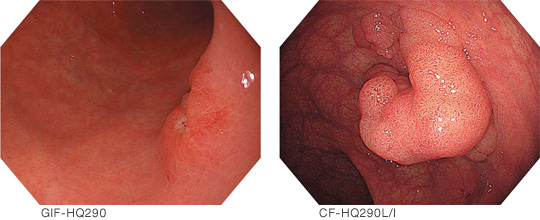
Dual Focus
Dual focus two-stage optical lens technology from OLYMPUS allows physicians to switch from normal focus mode to near focus mode with a single button, so they can conduct close examination of mucosal tissue and capillary networks. The new technology lets physicians select the desired depth of field and obtain high-quality images at the same time, bringing a new level of visualization to routine examinations.
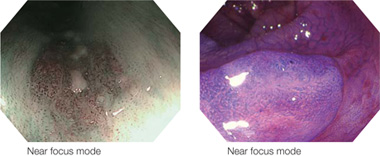
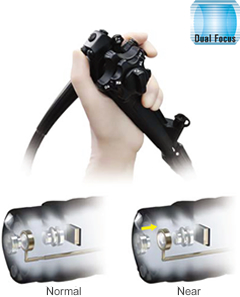
Wider Angle
The 170° wide-angle field of view is now available on all EVIS LUCERA ELITE 290 Series colonoscopes. The benefits of wide-angle endoscopy include brighter imaging on the periphery and a 30° wider field of view. This can help physicians to detect mucosal changes more rapidly with less need for angulation.

Responsive Insertion Technology
RIT consists of three technologies that work together to improve ease of insertion and operator control, which may help to minimize patient discomfort and enhance procedural efficiency.
Passive Bending
The new insertion section includes a soft passive bending section that better follows the passage through acute turns.
High Force Transmission
High Force Transmission enables a 1:1 transfer of pushing &rotating forces to the distal end of the colonoscope, improving ergonomics and scope responsiveness.
Variable Stiffness
Variable stiffness allows the flexibility a scope to be changed incrementally by manipulating a flexibility adjustment ring.
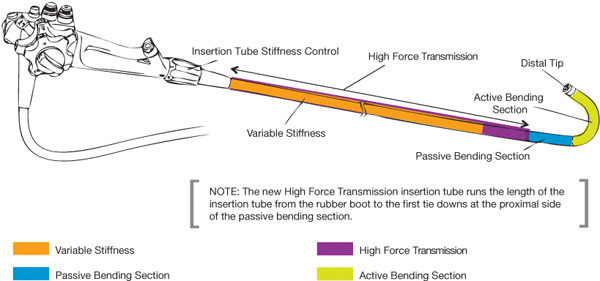
Passive Bending
This technology allows for smooth passage through acute flexures by allowing the distal tip of the scope to “deflect” and conform to the natural anatomy. Conventional scopes create a “candy cane” effect causing distended anatomy, patient discomfort and procedural difficulty.

High Force Transmission
High Force Transmission enables a 1:1 transfer of pushing & rotating forces to the distal end of the colonoscope, improving ergonomics and scope responsiveness.

Variable Stiffness
Variable stiffness allows the flexibility of a scope to be changed incrementally by manipulating a flexibility adjustment ring.

NBI (Narrow Band Imaging)
NBI is an optical image enhancement technology that enhances the visibility of vessels and other tissue on the mucosal surface. NBI works by filtering the white light into specific light wavelengths, which are absorbed by haemoglobin and penetrate only the surface of human tissue. This provides improved visual contrast of the surface structures and fine capillary patterns of mucous membranes, which are normally difficult to distinguish.
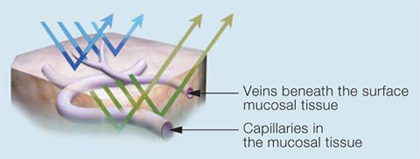
Developed to enhance vascular and surface patterns, NBI now features twice the viewable distance, improved noise reduction that works more efficiently, and image response speed from dark to bright is much faster. These advances help physicians to detect and characterize lesions even more effectively. Many experts agree that NBI can contribute to real-time diagnosis of adenoma and hyperplasia, potentially reducing the frequency of unnecessary biopsies and the costs associated with histopathological examinations. Potential benefits like these, together with NBI's proven practical advantages, are laying the foundations for a new paradigm in endoscopy.
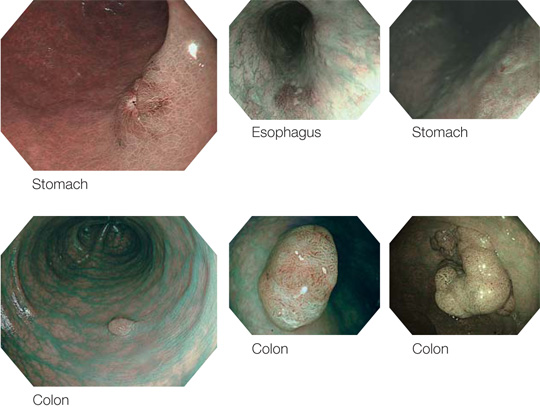
AFI (Auto Fluorescence Imaging)
AFI is a technology that highlights inflamed and neoplastic tissues in sharp, clear, high-contrast images to readily distinguish between healthy and unhealthy tissue, for the early detection of lesions. It operates by irradiating excitation light (390 to 470 nm) to observe auto fluorescence emitted from fluorescent substances such as collagen, and light of a wavelength (540 to 560 nm) that is absorbed by circulating haemoglobin. Auto fluorescence is an extremely weak light that conventional CCDs can barely detect, but combined with OLYMPUS’ AFI-compatible scope, which incorporates a high-sensitivity CCD, clear and reliable images can be achieved.
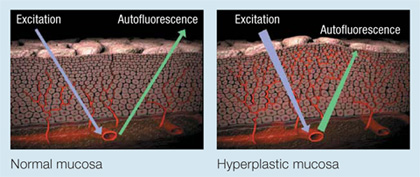
Developed to enhance vascular and surface patterns, NBI now features twice the viewable distance, improved noise reduction that works more efficiently, and image response speed from dark to bright is much faster. These advances help physicians to detect and characterize lesions even more effectively. Many experts agree that NBI can contribute to real-time diagnosis of adenoma and hyperplasia, potentially reducing the frequency of unnecessary biopsies and the costs associated with histopathological examinations. Potential benefits like these, together with NBI's proven practical advantages, are laying the foundations for a new paradigm in endoscopy.
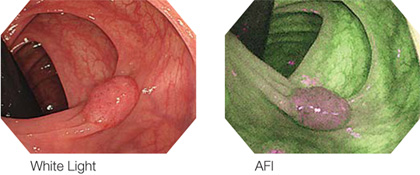
ScopeGuide
ScopeGuide can be integrated with EVIS LUCERA ELITE system to provide a quick custom setup that enables both the endoscopic and ScopeGuide image to be shown on the same monitor. The ability to visualize the scope inside the body allows the physician to see loop formations as they occur for expedited loop management. It can also assist with scope insertion and help optimize scope handling, which may shorten procedure times and minimize patient discomfort even during difficult colonoscopies.
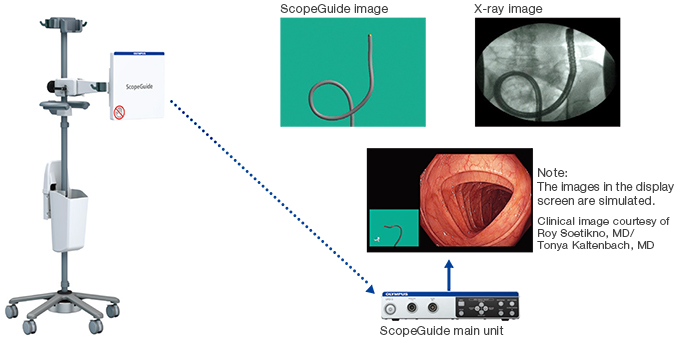
Imaging Systems
Gastroscopes
Colonoscopes
Duodenoscope
Enteroscope
Bronchoscopes
Contents end



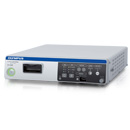
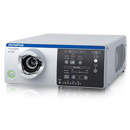
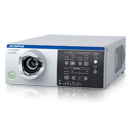
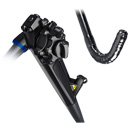

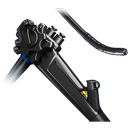
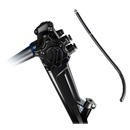

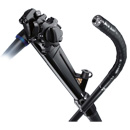
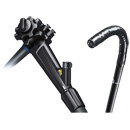



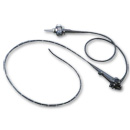
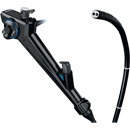
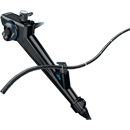
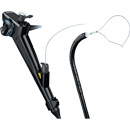
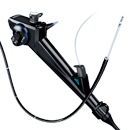
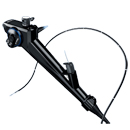
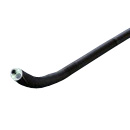

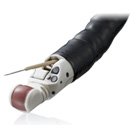

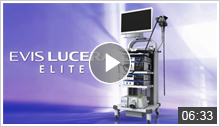
 VISERA ELITE III Video System Center
VISERA ELITE III Video System Center VISERA ELITE III LED Light Source
VISERA ELITE III LED Light Source 4K Camera Head
4K Camera Head ENDOEYE FLEX 3D
ENDOEYE FLEX 3D Bipolar Electrosurgical Instrument
Bipolar Electrosurgical Instrument